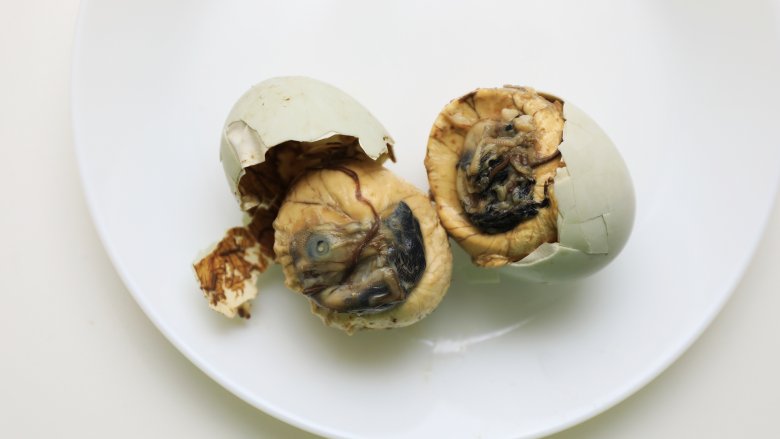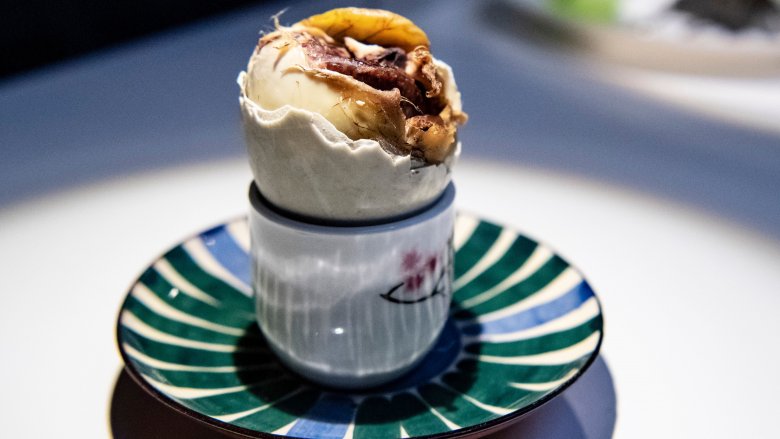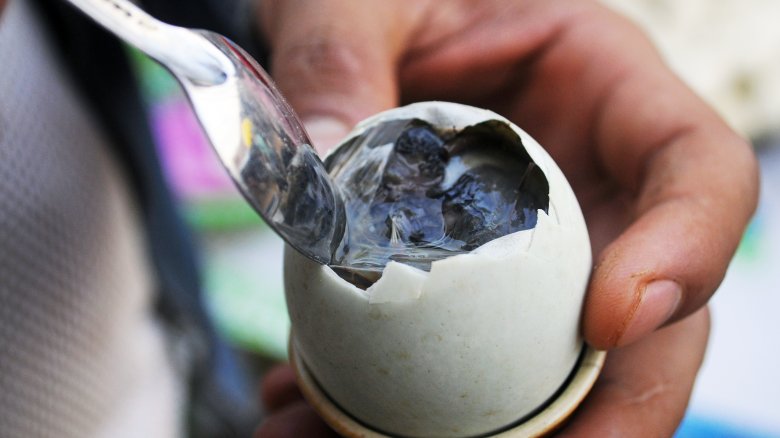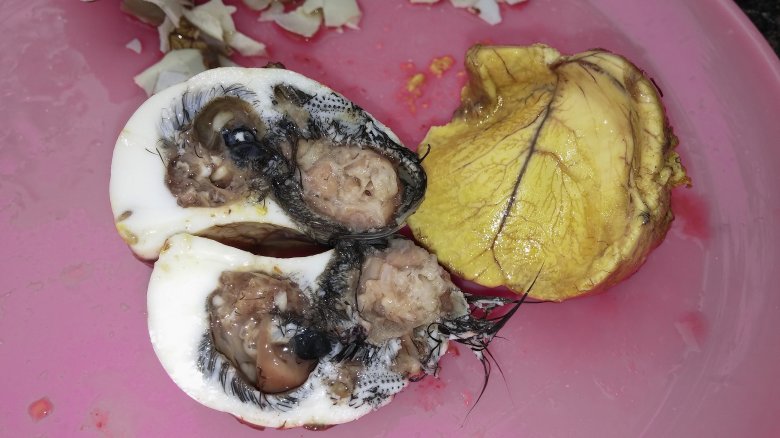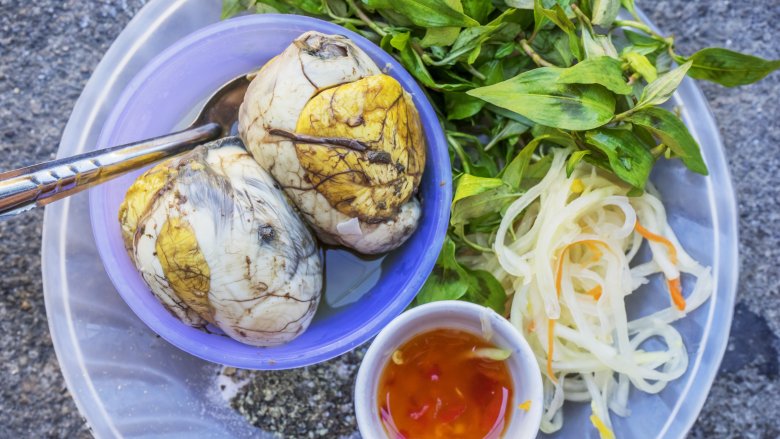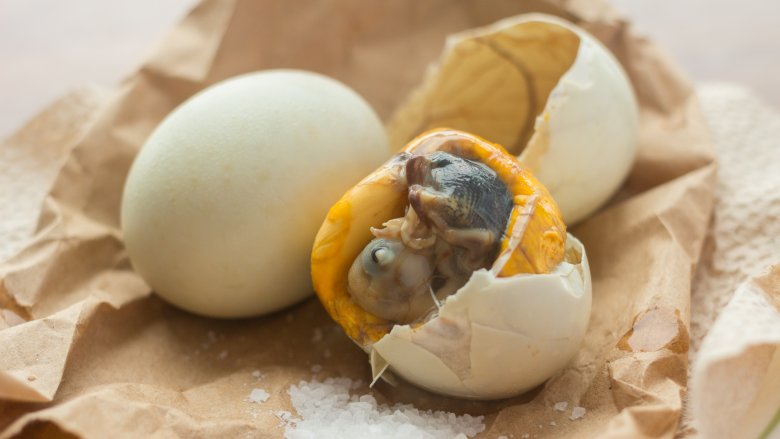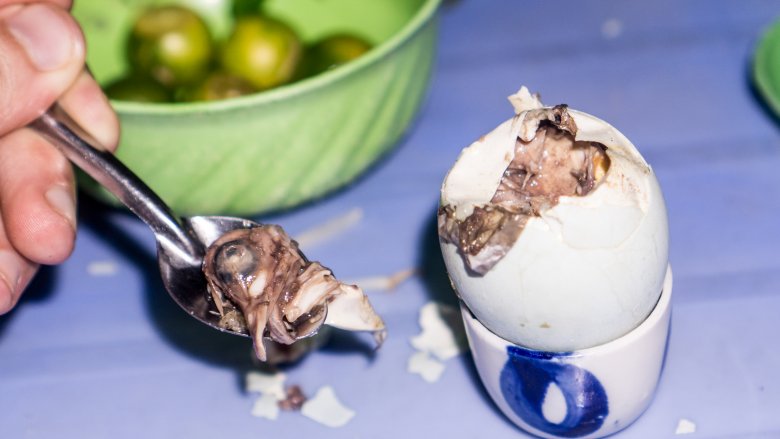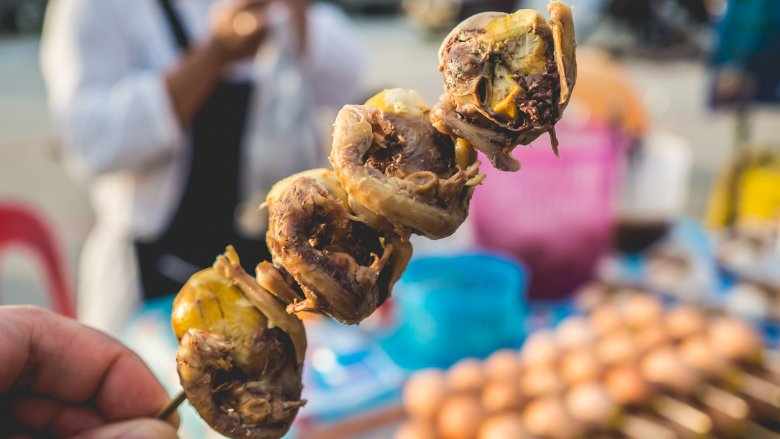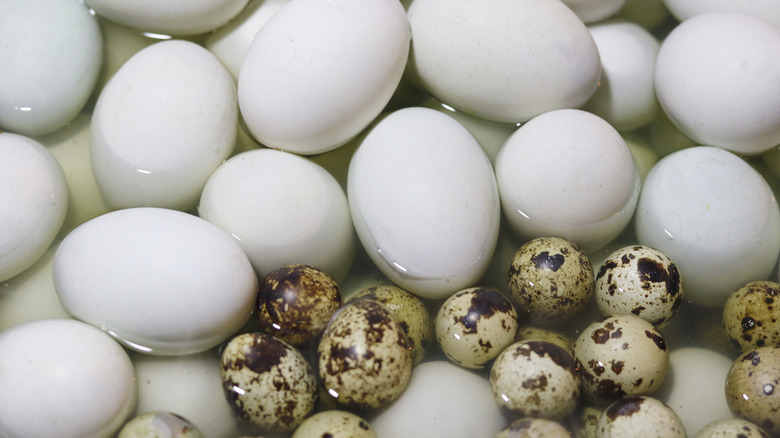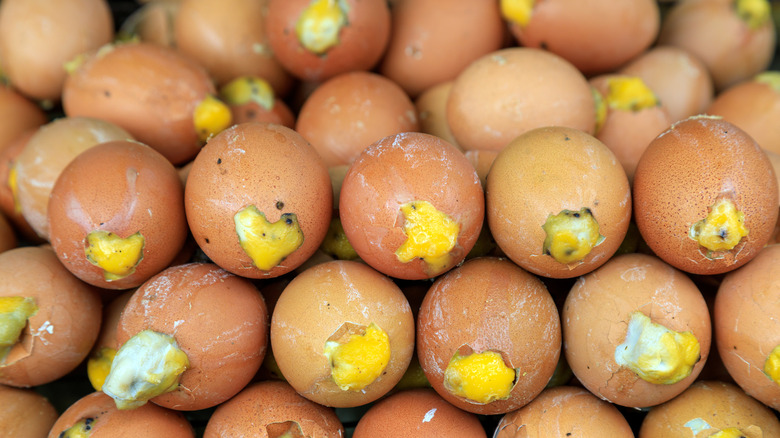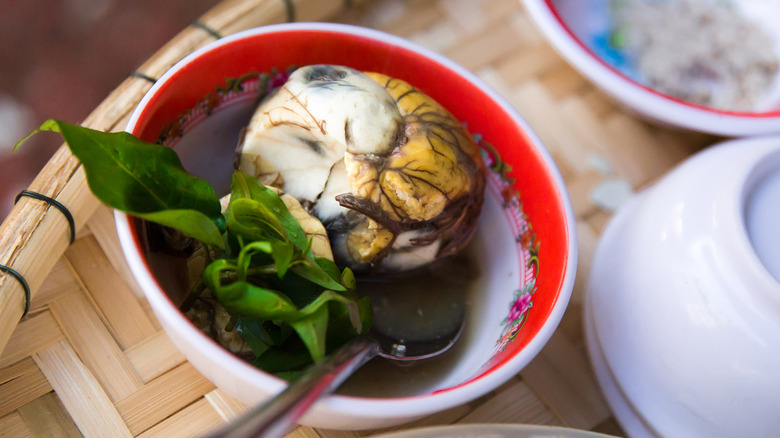The Untold Truth Of Balut
Balut is considered to be one of the first exotic food delicacies of the Philippines. Inspired by Chinese culture, balut dates back to almost 200 years ago. What once was considered a high-class dish is now enjoyed with a cold beer. It's as casual as an ice cream on a hot summer day and as pivotal an inclusion in the Philippines as ketchup is on a hot dog. Though when one sees balut for the first time, the reaction may not be the same as a hot dog. Without the understanding of the culture in which it was brought up, it's easy to say, "no, thank you."
For the Philippines, balut isn't just something to be enjoyed, but a way of life. Back in the 1950s, the municipality of Pateros had around 400,000 ducks producing eggs that would soon become balut, the number one industry in the area. But, what exactly does a duck have to do with balut? What makes it such a favorite among the Filipino culture? Let's start cracking the shell on balut and dive into the thick of it.
What is balut?
Balut is a street food widely consumed in the Philippines, but is also popular in places like Vietnam, where it's called hot vit lon, Thailand, China, Malaysia and other southeast Asian countries. There's no creative way to describe balut, but to just tell it like it is — it's a fertilized duck egg. Yes, it's a duck egg that has been incubated at about 104 degrees for a specific period of time. The fertilization process for balut ranges from 16-20 days. So, that means inside this fertilized duck egg is an embryo that is about a week short of hatching. If you can stomach it enough to picture it, this far in the development process the embryo will have feathers and a beak.
There you have it. Balut, a delicacy that has been a staple in the Filipino culture for more than 200 years, is an unhatched baby duck. Unusual? Probably for most Americans, but not so much in the Philippines where other popular foods consist of Kare-Kare (oxtail stew) and Kaldereta, another type of meaty stew soaked in liver sauce.
How is balut prepared?
Those brave enough to take a balut vendor up on this Filipino delicacy will notice that the egg, when served, is warm. Balut is prepared similarly to that of a hard-boiled egg except it is not cooled before serving. Instead, the fertilized duck egg is placed in boiling water for 20-30 minutes and eaten as soon as it reaches the right consistency.
Typically in the Philippines, balut is seasoned with either salt, vinegar, or soy sauce; however, if you venture to places such as Vietnam, you'll find a different way to spice things up. Here, balut, or if you remember in Vietnam it's called hot vit lon, is seasoned with salt, pepper, and Vietnamese coriander, an herb very similar in taste to cilantro. The seasonings come, of course, after the egg has been cracked and peeled open.
How do you eat balut?
For those with a desire to try balut, the full experience is actually a bit of a process. Nicole Ponseca is the owner of Maharlika, a Filippino restaurant in Manhattan's East Village, who gives quite a detailed breakdown of how someone would go about trying balut.
The process starts with the egg and spoon. While holding the egg in one hand you'll give the shell a few hard hits with the bottom of the spoon until it cracks open. Once cracked, the top of the shell is removed and the broth that fills the egg is sipped to reveal two separate parts of the egg. On one side you'll see the yolk and on the other the duck. Ponseca saves the duck for last, eating the whipped yolk first and taking the remainder down in one last bite. The whole process takes about a minute for someone who seemingly has done this many times before, but we're willing to bet it may take a bit longer for those trying it for the first time.
What does balut taste like?
With all the parts of balut that come after the shell is cracked, it's not surprising that there would be different flavors one experiences from beginning to end. In a few different Reddit threads, the juice that comes once the egg is cracked seems to have a similar taste across the board. One member describes it as a meaty broth and the other as watery chicken broth. Part one seems pretty straight forward. After the juice, comes the egg yolk which can be described as light in texture and creamy or even like custard. That part doesn't seem so bad, but what comes next might not be for everybody
When it comes to the texture of the actual duck, there seems to be mixed signals. While some say the meat is tender, dissolving in your mouth as it goes down; others beg to differ. Speaking to Chicago Reader, chef Kristine Subido remembered her distaste for balut while growing up in the Philippines. She shied away from it for more than 15 years before trying it again, saying, "There's a little bit of a crack and crunch when you're eating it." That crack and crunch is the beak, the feet, and the bones.
Balut is a late night snack of choice in the Philippines
Balut is to the Philippines what hot dogs are to America. You know, the stop you make at the cart on the corner after a late night out and put in an order for a hot dog with everything. Your mouth waters as you take that first bite. It may be hard to fathom, but when the sun goes down, balut vendors pop up along the crowded streets just like hot dog carts.
Walk around the streets at night in the Philippines and you'll hear the common shout-out of the delicacy for those strolling by. Being high in protein and other essential nutrients, those in the Philippines find balut to be a cheap alternative to vitamins. After a long night out, it's their saving grace. "It's like a power bar," says balut distributor Butch Coyoca, "people would eat one or two before they go to bed because they would believe that (balut) would compensate for whatever losses they incurred for not sleeping enough."
Some say it's an aphrodisiac
If you're not convinced quite yet about the appeal of balut, this may seal the deal. Balut may be consumed by both men and women; however, for women, it's said to only be a source of energy and nutrition. Men have a little something else in mind when it comes to balut. Balut's high protein content and other nutritional additives not only give off energy, but also stirs up a lot of heat throughout the body, becoming a natural aphrodisiac. In fact, balut has even been called Filipino Viagra.
To confirm, Butch Coyoca, a first generation Filipino American and balut distributor, says out of all who purchase balut from him, 60% believe that it does increase sex drive in males. No wonder that 75% of his customers are males. It's also not surprising that balut would be a late night snack option consumed after a night out, but before one goes back to the bedroom.
Balut yolk is high in cholesterol
We've talked about balut being a high source of protein and many other essential nutrients, but one thing that is also high when it comes to balut is cholesterol. The yolk of one fertilized duck egg alone holds around 359 mg of cholesterol. That is 59 mg more than the daily FDA-recommended cholesterol intake of 300 mg.
Since balut is mostly consumed as a snack — and like potato chips, you can't eat just one — it wouldn't be hard for a balut lover's cholesterol levels to surge. High cholesterol can increase the risk of cardiovascular disease, but the FDA also says that cholesterol is good for the body as it helps the liver produce the necessary fluids to aid in the digestion of fat.
Finding a happy medium seems essential, but may be hard for those regular balut eaters. Since there are a total of four parts to balut, perhaps skipping the yolk now and then is a good compromise. That still leaves three other parts to be enjoyed.
Balut might cure a hangover
Depending on how much you have to drink the night before, you may be desperate enough to see if the rumors are true. Locals in the Philippines turn to balut as a remedy to cure a hangover. Why, you ask? Well, the rationale behind this theory is that the yolk in balut contains the amino acid cysteine. Cysteine breaks down toxins in the liver and assists in eliminating them from your body. This can be helpful when you have had one drink too many, but it's not clear how many balut you'd have to consume for the cure to take place.
Don't fret though if balut isn't readily available to you or you don't think you can handle balut as your hangover cure of choice. Cysteine can also be found in many other types of food, including broccoli, cheese, oats, yogurt, red meat, and garlic. So, if you were contemplating on whether or not to have than next drink, thankfully, you have options.
Balut eating contests exist
With all that we've learned so far, could you imagine joining fellow balut lovers and downing dozens of balut in less than five minutes? If so, you'll want to catch a flight to the Northeast where balut eating contests are rising in popularity.
Put on by Filipino-inspired restaurants Maharlika and Jeepney in Brooklyn, this New York City-based balut eating contest has brought out some real balut-loving competitors. Since this annual contest began, it has seen an impressive 40 baluts eaten in five minutes. Another competition across the state lines took place at the Filipino American Festival in New Jersey where some contestants have been able to consume 20 baluts in as little as two minutes and 22 seconds. Could you be the next balut-eating champion? You'll have to start practicing, as there seem to be some seriously talented eaters out there.
Westernization is decreasing the allure of balut
The once thriving balut industry is now struggling to stay afloat amidst plummeting demand. Vendors who were selling 6,000 balut a day are now lucky if they sell 500. While the struggling industry can be linked to the pollution of river water in large duck breeding areas of the Philippines, some say that the demise of the balut industry is actually the effect of western influence on the Filippino palate.
With the introduction of fast food restaurants such as McDonald's, Pizza Hut, Burger King, Wendy's, KFC, and many more into the Filipino culture, generations are being introduced to western culture very young. These types of restaurants are becoming a favorite among young Filipino children. If we know anything about fast food restaurants, it's that they are easily accessible. This makes it tough for small balut street vendors to compete with big chain fast food restaurants. As a child, if you had a choice between pizza or balut, which would you choose?
There's been a festival celebrating balut for more than three decades
When it comes to finding the best quality balut, search no further than Pateros, a municipality within the Philippines. Pateros is so well known for its production of balut that it has won the title of balut capital of the Philippines. No wonder Pateros is home to the annual Balut sa Puti festival. Held on the 31st of January each year, Pateros has been hosting this festival for more than three decades.
During the Balut sa Puti festival, the best balut makers from all around the Philippines show off the quality of this local delicacy. Festival goers will experience live music and cooking competitions, as well as having the honor of tasting what Pateros considers the best balut in the world. With the Western influence affecting the Filipino palate, the country's Department of Tourism is hoping that building up this annual festival will bring a revival to the balut industry.
Balut has been featured on reality TV
The TV show "Survivor," which pits competitors against each other in order to select the show's sole survivor, has had its share of intense challenges. Since its start, challengers were forced to eat pig brains, tarantulas, scorpions, and, you guessed it — balut.
While some "Survivor" fans would be happy to take on the delicacy challenge the show's host, Jeff Probst, doesn't share the same excitement. When asked what he would consider the most disgusting challenge dish of all time, without pause balut was the answer. "Those little heads, that tiny body, those light feathers," he told Entertainment Weekly. "And the craziest part of all, those are sold in Asian supermarkets in the same manner we sell potato chips." Probst clearly makes a better host than he would a competitor, as some survivors were able to complete the challenge. It's a small feat for what could potentially win someone a $1 million prize.
Where to buy balut in the United States
Because of its somewhat unappetizing nature and the fact that the embryo inside the shell is partially developed, people may assume that balut is banned in the U.S. However, despite its squeamish character, properly prepared balut is safe to eat and the USDA does not restrict the sale and consumption of balut. Furthermore, as it's considered to be an ethnic food, balut is not subjected to USDA inspection.
If you are an adventurous eater and would like to try balut, getting one in the U.S. is relatively easy. The best way is to head to your local Asian market or grocery store, especially one specializing in Filipino cuisine. Some duck farms sell balut eggs that you can easily order online. However, many are sold raw and require cooking at home, usually simply boiling them in water for 15 to 20 minutes and eating them while they are still warm. Local Filipino restaurants may also carry this specialty on the menu.
Apart from the classic duck version, you can get a batch of quail balut. As quail eggs are typically smaller, this might be a better entry-level version, though be aware that they are typically more expensive than duck eggs.
There are several balut variations
In Filipino cuisine, there are two main balut variations that differ based on how long the eggs have been incubated. The younger version, incubated for up to 16 days, is known as mamatong balut. It will have more liquid and a bigger proportion of egg whites that will mostly settle at the bottom, while the embryo will be piled on top of the yolk and the egg white. The second, longer-incubated version is known as balut sa puti. Because it's been incubated for 18 days, this version holds a larger embryo that is wrapped in a thin, white-colored film.
Apart from the classic balut, Filipino cuisine has a similar delicacy that uses an egg that has not been fertilized. Known as penoy, it is made the same way as the classic embryo balut. The eggs are incubated for a certain amount of time and are then boiled. Producers typically check whether the egg has developed an embryo and then decide whether it will be made into standard balut or penoy. This second version is also sold in two variations: one with a soupy consistency and another with a firmer texture.
There are some ethical concerns regarding balut
Besides squeamishness, many also question the ethics of consuming balut. After all, the duck embryo inside must die during the cooking process. Although humans are no strangers to killing animals for food, balut is controversial because the animal does not have time to develop properly and has no chance to live. Things went so far that one activist even started a petition to stop an NYC restaurant from serving balut. The petition has since disappeared from the web, but the issue of cooking and eating balut is still debated.
Balut is one of many foods sometimes labeled as unethical. Foie gras, which involves force-feeding geese before slaughter,might be one of the most controversial items on that list, but a similar narrative revolves around caviar, shark fin soup, and the consumption of whole songbirds known as ortolans. However, as ethics are often based on personal beliefs and the culture one is raised in, it is difficult to derive a general conclusion. Perhaps we can all agree that extremes like eating endangered species are morally questionable, but when it comes to a culturally-important food like balut, it's not all black and white.
